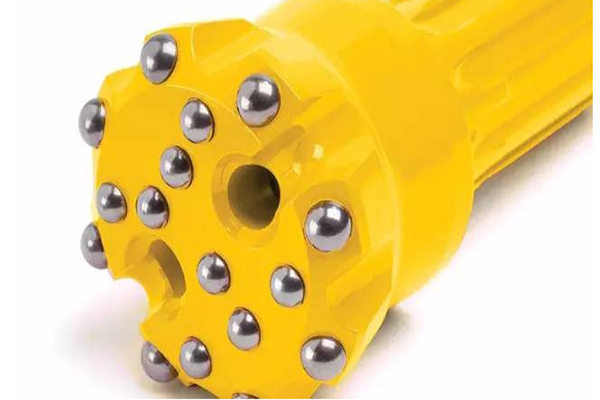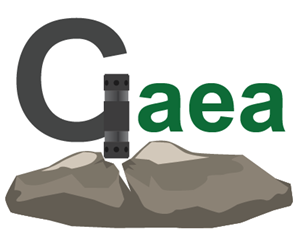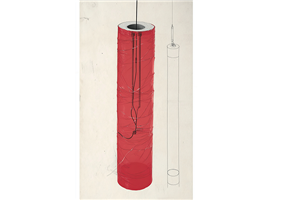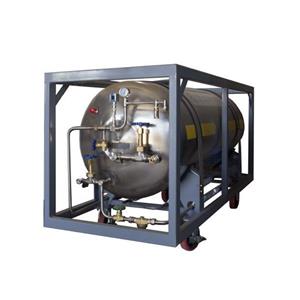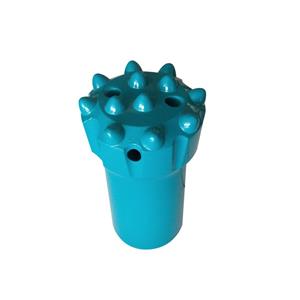Popularization of down-the-hole drilling tools knowledge and summary of detailed steps for daily preservation
Size selection of down-the-hole hammer, drill bit, and drill pipe
The size of the down-the-hole hammer mainly depends on the borehole diameter and rock type. For blasting holes, the borehole diameter range of down-the-hole drilling is from 89mm to 252mm. For boreholes smaller than 89mm, the top hammer type is mainly selected, and for boreholes larger than 252mm, the multi-purpose rotary drilling method is selected.
Generally speaking, the minimum borehole diameter that a down-the-hole hammer can be applied to is its nominal size, which means that the minimum borehole diameter applicable to a 4-inch hammer is a 4-inch borehole diameter. Generally speaking, in this case, there is enough annular space between the hammer and the hole wall, and between the drill pipe and the hole wall for slag removal.
The maximum size of the matching drill bit is the hammer size plus 1 inch. For example, the maximum drill bit size that matches a 4-inch hammer is 5 inches.
The closer the outer diameter of the drill pipe is to the outer diameter of the hammer, the better it is, which can ensure better slag removal and reduce the possibility of drill jamming.
In terms of the processing technology of drill pipes (drill rods), the surface finish and dimensional accuracy of cold-drawn tubes are better than those of hot-rolled tubes. Good surface finish means that the steel pipe surface is not easy to peel, and the metal debris caused by peeling will reduce the service life of the impactor. In addition, it is better if the thread and the main body of the drill pipe are connected by friction welding, which can increase the strength of the drill pipe. At the same time, the heat treatment of the thread part is done well, which can increase the reliability and strength of the thread, make the connection and unloading of the rod smoother, and improve work efficiency and overall drilling speed.
Choose a suitable down-the-hole drill bit
Let's take a look at the drill bit. The body of the drill bit is usually machined by cemented carbide, and then heat treated to a specified hardness to make the surface compressive stress have sufficient fatigue resistance, and then cemented carbide drill teeth are embedded.
The convex and pointed tooth drill bit design can achieve the fastest drilling efficiency and is most suitable for medium-soft rock with low abrasiveness.
For hard rock with high abrasiveness, a flat drill bit can increase the life of the drill bit. If the outer edge of the ball tooth is large enough, the drill bit life can be increased by grinding the drill bit multiple times to reduce the cost of use. In addition, the drill bit with concave ball teeth can also be used for such hard rock with high abrasiveness.
As shown in the figure below, the concave drill bit is more suitable for medium-hard rocks with developed joints and many cracks, which can effectively reduce the probability of hole deviation, which has also been mentioned in the previous article series.
Practical application
Drilling in open-pit mines and quarries usually requires more durable down-the-hole impactors, because quarries usually work for a long time, and it is not cost-effective to replace the impactors frequently. Some better down-the-hole impactors can be repaired and used many times before being completely replaced, such as changing the direction of the outer tube of the impactor.
Drilling of building stones (marble, etc.) pays more attention to hole straightness. In drilling holes with a diameter greater than 89mm, the down-the-hole type usually has better hole straightness than the top hammer type.
Exploration drilling needs to work in relatively remote construction sites with poor related facilities. Therefore, the requirements for down-the-hole impactors are simple design, high reliability, and adaptability to high wind pressure drilling.
Reverse circulation impact drilling is also commonly used. This sampling method is relatively cost-effective compared to diamond core drilling. The process used by the reverse circulation hammer is the same as that of the ordinary down-the-hole hammer, but it uses a reverse circulation drill pipe. High-pressure air is blown in through the gap between the inner and outer walls of the drill pipe, and then the drill cuttings are discharged from the inner wall of the drill pipe. The drill cuttings are then collected by a dust bag, as shown in the figure below.
In actual use, an important factor should always be considered, that is, the drill operator. An experienced drill operator can reduce the probability of hammer failure and increase the life of the hammer by effectively adjusting the drilling parameters.
There are many hammer options on the market, some cheap and some high-end. However, the value of the hammer is not only to look at its materials and design itself, but more importantly, it is necessary to consider the balance between the efficiency and rock meter cost brought to the user.
For example, a hammer is very cheap and durable, but the fuel consumption is very high, resulting in a high rock meter cost, which cannot be said to be a good hammer. Another hammer is very expensive, but it also brings high efficiency and low cost per rock meter, so this is a good hammer.
Of course, as a user, we also need to consider whether the impactor manufacturer can provide sufficient technical support and usage guidance. This is also very important and can effectively help our users improve drilling efficiency and reduce usage costs.
